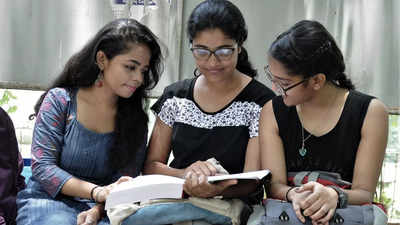- News
- Education News
- News
- CUET UG 2024: Scoring System & Section-Wise Preparation Tips
Trending
CUET UG 2024: Scoring System & Section-Wise Preparation Tips
The Common University Entrance Test (CUET) for undergraduate programs revolutionizes higher education admissions, ensuring fairness and equal opportunities. Administered by the National Testing Agency (NTA) from May 15 to May 31, CUET scores hold substantial weightage for admission to esteemed institutions like Delhi University, BHU, JNU, and others. With three sections and a flexible subject selection option, CUET assesses candidates comprehensively. Understanding its scoring system and section-wise preparation strategies are vital for aspirants aiming for success.

Representative Image.
The Common University Entrance Test (CUET) for undergraduate (UG) programs stands as a significant milestone in the realm of higher education admissions in India. Since its inception in 2022, CUET has emerged as a cornerstone in reshaping the landscape of university admissions, ensuring fairness and equal opportunities for candidates from diverse backgrounds across the nation.By standardizing the entrance process, CUET has revolutionized how students vie for coveted spots in prestigious universities, marking a paradigm shift towards a more transparent and merit-based approach in higher education admissions.
Acting as a unifying platform, the Common University Entrance Test (CUET) facilitates seamless interaction between students and esteemed universities, fostering a stronger bond between aspiring scholars and their academic destinations. Scheduled for 2024, the National Testing Agency (NTA) will administer the exam online, spanning from May 15 to May 31. The scores obtained in this exam will hold considerable weightage in the admission processes of prestigious institutions like Delhi University, BHU, JNU, Vishwa Bharati University, Allahabad University, among others, elevating CUET's significance in shaping the academic trajectories of countless aspirants.
CUET 2024 Exam Pattern
The CUET 2024 examination is structured into three distinct sections, each designed to assess various aspects of the candidates' academic aptitude and proficiency. Below is a detailed breakdown of the exam pattern:
Candidates have the flexibility to choose between 3 to 6 subjects from the amalgamated pool of all three sections in the CUET examination. The marking scheme is structured to award five marks for each correct response, while imposing a penalty of one mark for every incorrect answer. Notably, there are no deductions for unanswered questions, offering candidates the liberty to strategize their attempts judiciously to optimize their scores effectively.
Understanding CUET Scoring System
The Common University Entrance Test (CUET) serves as a standardized assessment for admission into diverse undergraduate programs offered by over 250 Indian universities. To comprehend the scoring mechanism, it's imperative to grasp the intricacies of the CUET exam pattern, which consists of three main sections: Sections I, II, and III.
Section I: This section comprises two sub-sections - IA and IB. IA assesses language proficiency in 13 languages, while IB delves into proficiency in an additional 20 languages. Both sub-sections present 50 questions each, out of which candidates must attempt 40 questions.
Section II: Following the language assessment, Section II focuses on domain-specific subjects. Candidates are required to attempt 40 out of 45 or 50 questions, depending on the specific subjects chosen.
Section III: The final section, Section III, encompasses a General Test, featuring 60 questions in total. Candidates are expected to attempt 50 questions.
Below is a breakdown of the scoring parameters for each section:
Understanding the scoring system enables candidates to devise effective strategies and strive for optimal performance in the CUET examination, thereby enhancing their prospects for admission into prestigious undergraduate programs across Indian universities.
Section-Wise Preparation
• Section I (A & B): Languages: In this segment, candidates have the option to select from a diverse range of 13 languages, encompassing Telugu, Tamil, Marathi, Hindi, Urdu, Malayalam, Kannada, Gujarati, Bengali, Assamese, Punjabi, Odia, and English. This section emphasizes comprehension and interpretation skills, with reading comprehension passages designed to evaluate candidates' abilities across factual, academic, and narrative contexts. Aspirants are encouraged to engage in regular practice sessions to enhance their language proficiency and adeptness in comprehending varied textual formats.
• Section II: Domain-Specific: Section II necessitates thorough preparation grounded in the Class 12 NCERT curriculum, as all questions are aligned with this educational level. Candidates are advised to focus on grasping the fundamental concepts elucidated in their NCERT textbooks to excel in domain-specific subjects. A meticulous review of the prescribed syllabus, coupled with consistent practice of sample questions and mock tests, can bolster candidates' confidence and proficiency in tackling subject-specific inquiries effectively.
• Section III: General Test: The General Test constitutes a comprehensive assessment of candidates' knowledge across diverse domains, encompassing general knowledge, mental ability, numerical ability, quantitative reasoning, and logical and analytical reasoning. While the syllabus for this section may not be explicitly defined, candidates can undertake a proactive approach by cultivating a broad understanding of various topics to augment their overall knowledge base and sharpen their reasoning abilities. Engaging in regular reading, staying updated with current affairs, and practicing problem-solving exercises can significantly enhance candidates' preparedness for the General Test, enabling them to navigate through its multifaceted challenges with confidence and proficiency.
Acting as a unifying platform, the Common University Entrance Test (CUET) facilitates seamless interaction between students and esteemed universities, fostering a stronger bond between aspiring scholars and their academic destinations. Scheduled for 2024, the National Testing Agency (NTA) will administer the exam online, spanning from May 15 to May 31. The scores obtained in this exam will hold considerable weightage in the admission processes of prestigious institutions like Delhi University, BHU, JNU, Vishwa Bharati University, Allahabad University, among others, elevating CUET's significance in shaping the academic trajectories of countless aspirants.
CUET 2024 Exam Pattern
The CUET 2024 examination is structured into three distinct sections, each designed to assess various aspects of the candidates' academic aptitude and proficiency. Below is a detailed breakdown of the exam pattern:
Candidates have the flexibility to choose between 3 to 6 subjects from the amalgamated pool of all three sections in the CUET examination. The marking scheme is structured to award five marks for each correct response, while imposing a penalty of one mark for every incorrect answer. Notably, there are no deductions for unanswered questions, offering candidates the liberty to strategize their attempts judiciously to optimize their scores effectively.
Understanding CUET Scoring System
The Common University Entrance Test (CUET) serves as a standardized assessment for admission into diverse undergraduate programs offered by over 250 Indian universities. To comprehend the scoring mechanism, it's imperative to grasp the intricacies of the CUET exam pattern, which consists of three main sections: Sections I, II, and III.
Section I: This section comprises two sub-sections - IA and IB. IA assesses language proficiency in 13 languages, while IB delves into proficiency in an additional 20 languages. Both sub-sections present 50 questions each, out of which candidates must attempt 40 questions.
Section II: Following the language assessment, Section II focuses on domain-specific subjects. Candidates are required to attempt 40 out of 45 or 50 questions, depending on the specific subjects chosen.
Section III: The final section, Section III, encompasses a General Test, featuring 60 questions in total. Candidates are expected to attempt 50 questions.
Below is a breakdown of the scoring parameters for each section:
Understanding the scoring system enables candidates to devise effective strategies and strive for optimal performance in the CUET examination, thereby enhancing their prospects for admission into prestigious undergraduate programs across Indian universities.
Section-Wise Preparation
• Section I (A & B): Languages: In this segment, candidates have the option to select from a diverse range of 13 languages, encompassing Telugu, Tamil, Marathi, Hindi, Urdu, Malayalam, Kannada, Gujarati, Bengali, Assamese, Punjabi, Odia, and English. This section emphasizes comprehension and interpretation skills, with reading comprehension passages designed to evaluate candidates' abilities across factual, academic, and narrative contexts. Aspirants are encouraged to engage in regular practice sessions to enhance their language proficiency and adeptness in comprehending varied textual formats.
• Section II: Domain-Specific: Section II necessitates thorough preparation grounded in the Class 12 NCERT curriculum, as all questions are aligned with this educational level. Candidates are advised to focus on grasping the fundamental concepts elucidated in their NCERT textbooks to excel in domain-specific subjects. A meticulous review of the prescribed syllabus, coupled with consistent practice of sample questions and mock tests, can bolster candidates' confidence and proficiency in tackling subject-specific inquiries effectively.
• Section III: General Test: The General Test constitutes a comprehensive assessment of candidates' knowledge across diverse domains, encompassing general knowledge, mental ability, numerical ability, quantitative reasoning, and logical and analytical reasoning. While the syllabus for this section may not be explicitly defined, candidates can undertake a proactive approach by cultivating a broad understanding of various topics to augment their overall knowledge base and sharpen their reasoning abilities. Engaging in regular reading, staying updated with current affairs, and practicing problem-solving exercises can significantly enhance candidates' preparedness for the General Test, enabling them to navigate through its multifaceted challenges with confidence and proficiency.
End of Article
FOLLOW US ON SOCIAL MEDIA










